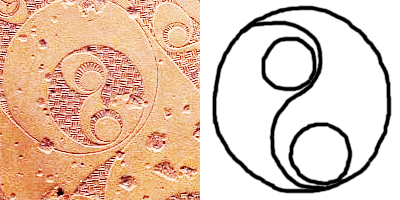
This page created 23 March 2014, and last modified: 13 November 2014 (Maier reference numbers added)

The Armigeri defensores seniores is listed (98/9.101 in Ingo Maier's numbering scheme) as fourth of the 32 legiones comitatenses under the Magister Peditum and assigned (102/5.132) to the Magister Equitum's Gallic command under the same name. Its shield pattern (95#15) is shown in various manuscripts under the label (95.p) Armigeri as below:

The shield pattern features a red rim with a main field divided into two with a swirling taiji or "yin-yang" pattern in yellow and purple (more indigo in P, and faded to maroon in M, W); each of the two lobes has a central disc coloured red (white in M). Despite the shield pattern's resemblance to the well-known Chinese Taoist pattern, it should be noted that the yin-yang / taijitu pattern is not known from Chinese sources until something like 500 years after the date of the composition of the original Notitia (see also the Mauri Osismiaci, also in the Gallic field army, and which carries a similar shield pattern).
Closer to the Notitia than Song China in terms of both geographical origin and time, are Celtic motifs. Below left is a detail from the Desborough mirror, a bronze mirror dated to 50 BC - 50 AD found in 1908 in Northamptonshire, England.

Swirling S-curves such as featured in the Desborough mirror are a common feature in early Celtic art (especially in the British isles); often three such whorls will come together to form a triskeles. Such a Celtic motif would be particularly appropriate pattern for a unit serving in the Gallic field army.
Possible inscriptional evidence for the Armigeri defensores seniores comes from the cemetery at Colonia Iulia Concordia (modern Portogruaro in Veneto, Italy), which produced an inscription (CIL 5, 8747) mentioning a NUMERO ARMIGERORUM; see here for Hoffmann's 1963 analysis (in German). Of course, this could well refer to one of the other Armigeri units mentioned in the Notitia, or even an Armigeri unit that is not mentioned in the Notitia, such as the unattested Armigeri defensores iuniores.
Armigeri has a broad meaning of "one who is equipped, especially for war", and probably implying armoured in particular. While it is of course entirely possible that the men of this legion were particularly well armoured (at least, at the time they were formed), another explanation could be that they earned the description as a nickname or badge of merit: see here for more details on armgeri. Defensores means "defenders" or "champions"; as does the word propugnatores, which is also born by certain armigeri units: the Armigeri propugnatores seniores and the Armigeri propugnatores iuniores, both under the Comes Africae.
Given the similarity in names, it is likely that the Armigeri defensores seniores is the same unit as the men formerly commanded by the Praefectus militum armigerorum at Mogontio under the Dux Mogontiacensis (unless they represent a later destroyed iuniores unit); see under his entry for details.

Return to the Notitia alphabetical unit list page.
Return to my Notitia index page.